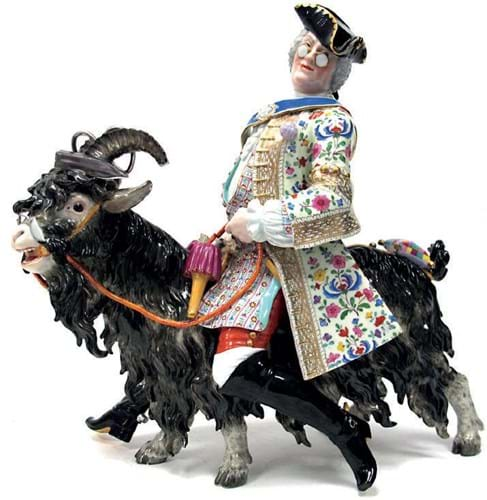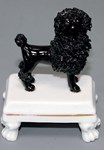However, when in 1737 the tailor dared ask for an invitation to dine with the court, the count found the suggestion beyond the pale.
To put a mere tradesman in his place, the count (who had been appointed administrator of the Meissen factory in 1733) asked that the great modeller JJ Kändler make a suitable figure of the tailor which he could place on his table.
The spectacles hung from the goat’s horns were provided so that the tailor may have his eyes opened and see his proper station in life.
The colourful and absurd figure has long caught the public’s imagination although most, such as this one offered for sale at Sheffield Auction Gallery (19% buyer’s premium) on March 20, date from the late 19th or early 20th century.
Measuring a substantial 17½in (43cm) high and in generally good condition save the need to restore the horns, it sold in the middle of the estimate at £6000.
Last acts of Chelsea
Meissen-inspired rococo groups modelled on tales from Aesop’s Fables were among the last acts of the Chelsea porcelain factory under founder Nicholas Sprimont (1716-71).
Made from c.1765, at the end of the Gold Anchor period, figures such as these were included in the famous ‘Last Sale Catalogue of the Chelsea China of Mr N Sprimont’ held by one Mr James Christie on February 14, 1770.
At their collecting zenith a century ago, in recent years these elaborate wares have fallen victim to the whims of collecting and decorating fashion. However, there are signs that prices might be rebounding: 2018’s Peggy and David Rockefeller sale in particular included many strong prices for Gold Anchor figures.
Fantastic fox candlesticks
A pair of 12in (30cm) candlesticks was offered for sale at John Nicholson’s (25% buyer’s premium) in Fernhurst on March 19. One depicts the story of The Fox and the Goat in the Well, the other The Fox and the Wolf in the Well.
With provenance to Christie’s in 1980 and the collection of HJ Joel, a collector living at Grosvenor Square, Mayfair, they were offered for a modest £250-500 but sold for a punchier £2600.
The Gold Anchor period ended in August 1769 when, as the health of Sprimont deteriorated, the Chelsea concern was sold first to a James Cox and again in February 1770 to William Duesbury (1725-86) and his partner John Heath, owners of the rival porcelain factory at Derby.
















